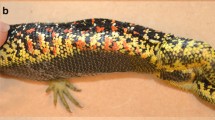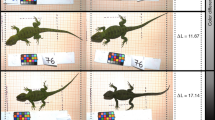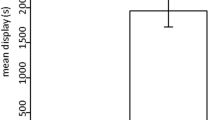Abstract
Behavior can help to establish dominance in intrasexual interactions, preventing more costly aggressive interactions and improving access to mates. Distinct color morphs often correlate with behavior, driving differential reproductive success between them. The lizard Tropidurus semitaeniatus usually expresses two male color morphs, Yellow or Black. It is likely that morphs play a role in reproduction, which is still unexplored. Here, we test whether there is morph-related dominance during intrasexual interactions. We used ex situ behavioral trials to test whether a particular morph shows dominance, gathering dominance by attributing scores to aggressive/evasive behaviors. We also tested whether winner individuals show higher performance (sprint speed), and whether spectrophotometric measures of body coloration predict winners of male encounters. Morphs showed differences in behaviors suggesting alternative behavioral tactics: Black males behave more aggressively and less evasively while Yellow males show the opposite sets of behavior. Black males also tend to be dominant, but dominants do not show higher sprint speeds than submissive males. Chest coloration, often displayed during encounters, highly predicts winnings (particularly high yellow chroma and low lightness and UV). Our results show that lizards signal competitive condition by behaviorally exposing their chest. Males displaying more head bobs and with darker chests are more likely to win encounters. Our results suggest that Yellow males might undertake a sneaker tactic, preventing aggression costs by evasiveness even though they might perform similarly to Black males. Further studies should address whether female preference is biased in relation to male morphs and its colorations, which would suggest selective processes towards costly signals and morph maintenance.
Significance statement
In the struggle for survival and reproduction, often, there is no single best strategy and multiple distinct tactics may evolve. Behavior, color signaling, and performance are frequently correlated with distinct color morphs, which can coexist as alternative mating tactics. However, studies that are able to integrate all these traits are scarce. Here, we test whether different color morphs of the lizard Tropidurus semitaeniatus show different behaviors and dominance patterns. We also test whether these color morphs differ in their performances (sprint speed) and visual signaling (behavioral displays and intensity of coloration). We demonstrate that Black and Yellow-morph males adopt distinct behavioral tactics: an aggressive (Black-morph) and an evasive (Yellow-morph) tactic. We also show that dominance is highly correlated to chest’s intensity of dark yellow colorations and that lizards signal their dominance status through displays of head bob bouts.




Similar content being viewed by others
References
Abalos J, Pérez i de Lanuza G, Carazo P, Font E (2016) The role of male coloration in the outcome of staged contests in the European common wall lizard (Podarcis muralis). Behaviour 153:607–631. https://doi.org/10.1163/1568539X-00003366
Alonso MLB, Cotrina JM, Pardo DA, Font E, Molina-Borja M (2010) Sex differences in antipredator tail-waving displays of the diurnal yellow-headed gecko Gonatodes albogularis from tropical forests of Colombia. J Ethol 28:305–311. https://doi.org/10.1007/s10164-009-0186-4
Andersson MB (1994) Sexual selection. Princeton University Press, Princeton
Andrade P, Pinho C, Pérez G et al (2019) Regulatory changes in pterin and carotenoid genes underlie balanced color polymorphisms in the wall lizard. P Natl Acad Sci 116:5633–5642
Arak A (1983) Sexual selection by male-male competition in natterjack toad choruses. Nature 306:261–262. https://doi.org/10.1038/306261a0
Bajer K, Molnár O, Török J, Herczeg G (2011) Ultraviolet nuptial colour determines fight success in male European green lizards (Lacerta viridis). Biol Lett 7:866–868. https://doi.org/10.1098/rsbl.2011.0520/r10.1111/j.1095-8312.2000.tb00221.x
Berglund A, Bisazza A, Pilastro A (1996) Armaments and ornaments: an evolutionary explanation of traits of dual utility. Biol J Linn Soc 58:385–399. https://doi.org/10.1006/bijl.1996.0043
Brandt R, Galvani F, Kohlsdorf T (2015) Sprint performance of a generalist lizard running on different substrates: grip matters. J Zool 297:15–21. https://doi.org/10.1111/jzo.12253
Bruinjé AC, Leivas PT, Costa GC (2018a) Characterisation of sexual dimorphism and male colour morphs of Tropidurus semitaeniatus (Spix, 1825) in three populations from northeast of Brazil. Herpetol Notes 11:755–760
Bruinjé AC, Moura MO, Maggi BS, São-Pedro VA, Pessoa DMA, Costa GC (2018b) Conspecifics of the Striped Lava Lizard are able to distinguish sex and male colour morphs in apparently homogeneous dull dorsal colouration. Amphibia-Reptilia published online. https://doi.org/10.1163/15685381-20181048
Carvalho ALG, Sena MA, Peloso PLV, Machado FA, Montesinos R, Silva HR, Campbell G, Rodrigues MT (2016) A new Tropidurus (Tropiduridae) from the semiarid Brazilian Caatinga: evidence for conflicting signal between mitochondrial and nuclear loci affecting the phylogenetic reconstruction of South American collared lizards. Am Museum Novit 3852:66–68. https://doi.org/10.1206/3852.1
Coelho FEA, Bruinjé AC, Costa GC (2018) Ethogram with the description of a new behavioral display for the striped lava lizard, Tropidurus semitaeniatus. S Am J Herpetol 13:96–101. https://doi.org/10.2994/SAJH-D-17-00101.1
Collins CE, Self JD, Anderson RA, McBrayer LD (2013) Rock-dwelling lizards exhibit less sensitivity of sprint speed to increases in substrate rugosity. Zoology 116:151–158. https://doi.org/10.1016/j.zool.2013.01.001
Cooper WE (1994) Chemical discrimination by tongue-flicking in lizards: a review with hypotheses on its origin and its ecological and phylogenetic relationships. J Chem Ecol 20:439–487. https://doi.org/10.1007/BF02064449
Deere KA, Grether GF, Sun A, Sinsheimer JS (2012) Female mate preference explains countergradient variation in the sexual coloration of guppies (Poecilia reticulata). Proc R Soc Lond B 279:1684–1690. https://doi.org/10.1098/rspb.2011.2132
Dijkstra PD, Hemelrijk C, Seehausen O, Groothuis TGG (2009) Color polymorphism and intrasexual competition in assemblages of cichlid fish. Behav Ecol 20:138–144. https://doi.org/10.1093/beheco/arn125
Endler J (1980) Natural selection on color patterns in Poecilia reticulata. Evolution 34:76–91. https://doi.org/10.2307/2408316
Evans MR, Goldsmith AR, Norris SRA (2000) The effects of testosterone on antibody production and plumage coloration in male house sparrows (Passer domesticus). Behav Ecol Sociobiol 47:156–163
Fernández JB, Bastiaans E, Medina M, Mendéz De la Cruz FR, Sinervo BR, Ibargüengoytía NR (2018) Behavioral and physiological polymorphism in males of the austral lizard Liolaemus sarmientoi. J Comp Physiol A 204:219–230. https://doi.org/10.1007/s00359-017-1233-1
Fitze PS, Cote J, San-Jose LM, Meylan S, Isaksson C, Andersson S, Rossi JM, Clobert J (2009) Carotenoid-based colours reflect the stress response in the common lizard. PLoS One 4:e5111. https://doi.org/10.1371/journal.pone.0005111
García-Navas V, Ferrer ES, Sanz JJ (2012) Plumage yellowness predicts foraging ability in the blue tit Cyanistes caeruleus. Biol J Linn Soc 106:418–429. https://doi.org/10.1111/j.1095-8312.2012.01865.x
Garland T Jr, Hankins E, Huey RB (1990) Locomotor capacity and social dominance in male lizards. Funct Ecol 4:243–250. https://doi.org/10.2307/2389343
Grether GF (2000) Carotenoid limitation and mate preference evolution: a test of the indicator hypothesis in guppies (Poecilia reticulata). Evolution 54:1712–1724. https://doi.org/10.1111/j.0014-3820.2000.tb00715.x
Haenel GJ, Smith LC, John-Alder HB (2003) Home-range analysis in Sceloporus undulatus (Eastern fence lizard). I. Spacing patterns and the context of territorial behavior. Copeia 2003:99–112. https://doi.org/10.1643/0045-8511(2003)003[0099:HRAISU]2.0.CO;2
Herrel A, Andrade DV, de Carvalho JE, Brito A, Abe A, Navas C (2009) Aggressive behavior and performance in the Tegu lizard Tupinambis merianae. Physiol Biochem Zool 82:680–685. https://doi.org/10.1086/605935
Hover EL (1985) Differences in aggressive behavior between two throat color morphs in a lizard, Urosaurus ornatus. Copeia 1985:933–940. https://doi.org/10.2307/1445244
Hurtado-Gonzales JL, Uy JAC (2010) Intrasexual competition facilitates the evolution of alternative mating strategies in a colour polymorphic fish. BMC Evol Biol 10:391. https://doi.org/10.1186/1471-2148-10-391
Jawor JM, Breitwisch R (2003) Melanin ornaments, honesty, and sexual selection. Auk 120:249–265. https://doi.org/10.1642/0004-8038(2003)120[0249:MOHASS]2.0.CO;2
Johnstone RA (1996) Multiple displays in animal communication:`backup signals’ and `multiple messages. Phil Trans R Soc B 351:329–338. https://doi.org/10.1098/rsta.1892.0001
Kabelik D, Weiss SL, Moore MC (2008) Steroid hormones alter neuroanatomy and aggression independently in the tree lizard. Physiol Behav 93:492–501. https://doi.org/10.1016/j.physbeh.2007.10.008
Kolodiuk MF, Ribeiro LB, Freire EMX (2009) The effects of seasonality on the foraging behavior of Tropidurus hispidus and Tropidurus semitaeniatus (Squamata: Tropiduridae) living in sympatry in the Caatinga of northeastern Brazil. Zoologia 26:581–585. https://doi.org/10.1590/S1984-46702009000300026
LeBas N, Marshall N (2000) The role of colour in signalling and male choice in the agamid lizard Ctenophorus ornatus. Proc R Soc Lond B 267:445–452. https://doi.org/10.1098/rspb.2000.1020
Lehnert SJ, Garver KA, Richard J, Devlin RH, Lajoie C, Pticher TE, Heath DD (2018) Significant differences in maternal carotenoid provisioning and effects on offspring fitness in Chinook salmon colour morphs. J Evol Biol 31:1876–1893
Lisboa CMCA, Bajer K, Pessoa DMA, Huber M, Costa GC (2017) Female Brazilian whiptail lizards (Cnemidophorus ocellifer) prefer males with high ultraviolet ornament reflectance. Behav Process 142:33–39. https://doi.org/10.1016/j.beproc.2017.05.009
Loew ER, Fleishman LJ, Foster RG, Provencio I (2002) Visual pigments and oil droplets in diurnal lizards: a comparative study of Caribbean anoles. J Exp Biol 205:927–938
Machado LL, Galdino CAB, Sousa BM (2007) Defensive behavior of the lizard Tropidurus Montanus (Tropiduridae): effects of sex, body size and social context. S Am J Herpetol 2:136–140. https://doi.org/10.2994/1808-9798(2007)2[136:DBOTLT]2.0.CO;2
Maia R, Eliason CM, Bitton PP, Doucet SM, Shawkey MD (2013) Pavo: an R package for the analysis, visualization and organization of spectral data. Methods Ecol Evol 4:906–913. https://doi.org/10.1111/2041-210X.12069
Martín J, López P (2009) Multiple color signals may reveal multiple messages in male Schreiber’s green lizards, Lacerta schreiberi. Behav Ecol Sociobiol 63:1743–1755. https://doi.org/10.1007/s00265-009-0794-6
Martins EP (1994) Phylogenetic perspectives on the evolution of lizard territoriality. In: Vitt L, Pianka ER (eds) Lizard ecology: historical and experimental perspectives. Princeton University Press, Princeton, pp 117–144
McCullough EL, Simmons LW (2016) Selection on male physical performance during male–male competition and female choice. Behav Ecol 27:1288–1295. https://doi.org/10.1093/beheco/arw033
McEvoy J, While GM, Sinn DL, Wapstra E (2013) The role of size and aggression in intrasexual male competition in a social lizard species, Egernia whitii. Behav Ecol Sociobiol 67:79–90. https://doi.org/10.1007/s00265-012-1427-z
McGraw KJ, Dale J, Mackillop EA (2003) Social environment during molt and the expression of melanin-based plumage pigmentation in male house sparrows (Passer domesticus). Behav Ecol Sociobiol 53:116–122
Moore MC, Hewsf DK, Knapp R (1998) Hormonal control and evolution of alternative male phenotypes: generalizations of models for sexual differentiation. Am Zool 38:133–151. https://doi.org/10.1093/icb/38.1.133
Osborne L (2005) Information content of male agonistic displays in the territorial tawny dragon (Ctenophorus decresii). J Ethol 23:189–197. https://doi.org/10.1007/s10164-005-0151-9
Pérez i De Lanuza G, Carretero MA (2018) Partial divergence in microhabitat use suggests environmental-dependent selection on a colour polymorphic lizard. Behav Ecol Sociobiol 72:138. https://doi.org/10.1007/s00265-018-2550-2
Pérez i De Lanuza G, Font E, Carazo P (2012) Color-assortative mating in a color-polymorphic lacertid lizard. Behav Ecol 24:273–279. https://doi.org/10.1093/beheco/ars164
Perry G, Levering K, Girard I, Garland T Jr (2004) Locomotor performance and social dominance in male Anolis cristatellus. Anim Behav 67:37–47. https://doi.org/10.1016/j.anbehav.2003.02.003
Pryke SR, Andersson S, Lawes MJ (2010) Sexual selection of multiple handicaps in the red-collared widowbird: female choice of tail length but not carotenoid display. Evolution 55:1452–1463
Puechmaille SJ, Borissov IM, Zsebok S, Allegrini B, Hizem M, Kuenzel S, Schuchmann M, Teeling EC, Siemers BM (2014) Female mate choice can drive the evolution of high frequency echolocation in bats: a case study with Rhinolophus mehelyi. PLoS One 9:e103452. https://doi.org/10.1371/journal.pone.0103452
Qi Y, Wan H, Gu H, Wang Y (2011) Do displays and badges function in establishing the social structure of male toad-headed lizards, Phrynocephalus vlangalii? J Ethol 29:381–387. https://doi.org/10.1007/s10164-010-0252-y
R Core Team (2017) R: A language and environment for statistical computing. R Foundation for Statistical Computing, Vienna, Austria https://www.R-project.org/
Regnier M, Herrera AA (1993) Changes in contractile properties by androgen hormones in sexually dimorphic muscles of male frogs (Xenopus laevis). J Physiol 461:565–581. https://doi.org/10.1113/jphysiol.1993.sp019529
Ribeiro LB, Silva NB, Freire EMX (2012) Reproductive and fat body cycles of Tropidurus hispidus and Tropidurus semitaeniatus (Squamata, Tropiduridae) in a caatinga area of northeastern Brazil. Rev Chil Hist Nat 85:307–320. https://doi.org/10.1590/S0073-47212011000200010
Robson MA, Miles DB (2000) Locomotor performance and dominance in male Tree Lizards, Urosaurus ornatus. Funct Ecol 14:338–344. https://doi.org/10.1046/j.1365-2435.2000.00427.x
Saenko SV, Teyssier J, van der Marel D, Milinkovitch MC (2013) Precise colocalization of interacting structural and pigmentary elements generates extensive color pattern variation in Phelsuma lizards. BMC Biol 11:105. https://doi.org/10.1186/1741-7007-11-105
Sánchez-Hernández P, Ramírez-Pinilla MP, Molina-Borja M (2012) Agonistic and courtship behaviour patterns in the skink Chalcides viridanus (Fam. Scincidae) from Tenerife. Acta Ethol 15:65–71. https://doi.org/10.1007/s10211-011-0109-6
Schall JJ, Dearing MD (1987) Malarial parasitism and male competition for mates in the western fence lizard, Sceloporus occidentalis. Oecologia 73:389–392. https://doi.org/10.1007/BF00385255
Seddon N, Botero CA, Tobias JA, Dunn PO, MacGregor HEA, Rubenstein DR, Uy JAC, Weir JT, Whittingham LA, Safran RJ (2013) Sexual selection accelerates signal evolution during speciation in birds. Proc R Soc B 280:20131065. https://doi.org/10.1098/rspb.2013.1065
Shuster SM, Wade MJ (2003) Mating systems and strategies. Princeton University Press, Princeton
Sih A, Bell A, Johnson JC (2004) Behavioral syndromes: an ecological and evolutionary overview. Trends Ecol Evol 19:372–378. https://doi.org/10.1016/j.tree.2004.04.009
Sinervo B, Lively CM (1996) The rock-paper-scissors game and the evolution of alternative male strategies. Nature 380:240–243. https://doi.org/10.1038/380240a0
Smith JM, Price GR (1973) The logic of animal conflict. Nature 246:15–18. https://doi.org/10.1038/246015a0
Stapley J, Whiting MJ (2006) Ultraviolet signals fighting ability in a lizard. Biol Lett 2:169–172. https://doi.org/10.1098/rsbl.2005.0419
Steffen JE, McGraw KJ (2009) How dewlap color reflects its carotenoid and pterin content in male and female brown anoles (Norops sagrei). Comp Biochem Physiol B 154:334–340. https://doi.org/10.1016/j.cbpb.2009.07.009
Taborsky M, Oliveira RF, Brockmann HJ (2008) The evolution of alternative reproductive tactics: concepts and questions. In: Oliveira RF, Taborsky M, Brockmann HJ (eds) Alternative reproductive tactics: an integrative approach. Cambridge University Press, Cambridge, pp 1–21
Tanaka K (2009) Does the thermal advantage of melanism produce size differences in color-dimorphic snakes? Zool Sci 26:698–703. https://doi.org/10.2108/zsj.26.698
Vercken E, Clobert J (2008) Ventral colour polymorphism correlates with alternative behavioural patterns in female common lizards (Lacerta vivipara). Ecoscience 15:320–326. https://doi.org/10.2980/15-3-3135
Vitt LJ (1981) Lizard reproduction: habitat specificity and constraints on relative clutch mass. Am Nat 117:506–514. https://doi.org/10.1086/283731
Vitt LJ, Goldberg SR (1983) Reproductive ecology of two tropical iguanid lizards: Tropidurus torquatus and Platynotus semitaeniatus. Copeia 1983:131–141
Weiss SL, Moore MC (2004) Activation of aggressive behavior by progesterone and testosterone in male tree lizards, Urosaurus ornatus. Gen Comp Endocrinol 136:282–288. https://doi.org/10.1016/j.ygcen.2004.01.001
Wild KH, Gienger CM (2018) Fire-disturbed landscapes induce phenotypic plasticity in lizard locomotor performance. J Zool 305:96–105. https://doi.org/10.1111/jzo.12545
Winchell KM, Maayan I, Fredette JR, Revell LJ (2018) Linking locomotor performance to morphological shifts in urban lizards. Proc R Soc B 285:20180229. https://doi.org/10.1098/rspb.2018.0229
Zahavi A (1975) Mate selection-a selection for a handicap. J Theor Biol 53:205–214. https://doi.org/10.1016/0022-5193(75)90111-3
Zajitschek SRK, Zajitschek F, Miles DB, Clobert J (2012) The effect of coloration and temperature on sprint performance in male and female wall lizards. Biol J Linn Soc 107:573–582. https://doi.org/10.1111/j.1095-8312.2012.01963.x
Acknowledgments
We thank the Universidade Federal do Rio Grande do Norte for the structure in which measurements and trials were performed. We also thank TC Bruinjé for assistance with analysis, and three anonymous reviewers which contributions significantly improved the paper.
Funding
We thank CAPES – Coordenação de Aperfeiçoamento de Pessoal de Nível Superior for AB’s PhD scholarship and PDSE fellowship (88881.135775/2016-01). This work was supported by CNPq – Conselho Nacional de Desenvolvimento Científico e Tecnológico (grant 474392/2013-9). GC thanks CNPq productivity grant (302297/2015-4).
Author information
Authors and Affiliations
Corresponding author
Ethics declarations
Ethical approval
All procedures performed in studies involving animals were in accordance with the ethical standards of the institution or practice at which the studies were conducted. Ethical approval was granted through the Ethics committee to the use of animals—CEUA (Protocol No. 040/2013). This study complies with all Brazilian regulations on ethical treatment of wild animal sampling under scientific investigations.
Conflict of interest
The authors declare that they have no conflict of interest.
Additional information
Communicated by S. J. Downes
Publisher’s note
Springer Nature remains neutral with regard to jurisdictional claims in published maps and institutional affiliations.
Electronic supplementary material
ESM 1
(DOC 50 kb)
Rights and permissions
About this article
Cite this article
Bruinjé, A.C., Coelho, F.E.A., Paiva, T.M.A. et al. Aggression, color signaling, and performance of the male color morphs of a Brazilian lizard (Tropidurus semitaeniatus). Behav Ecol Sociobiol 73, 72 (2019). https://doi.org/10.1007/s00265-019-2673-0
Received:
Revised:
Accepted:
Published:
DOI: https://doi.org/10.1007/s00265-019-2673-0




